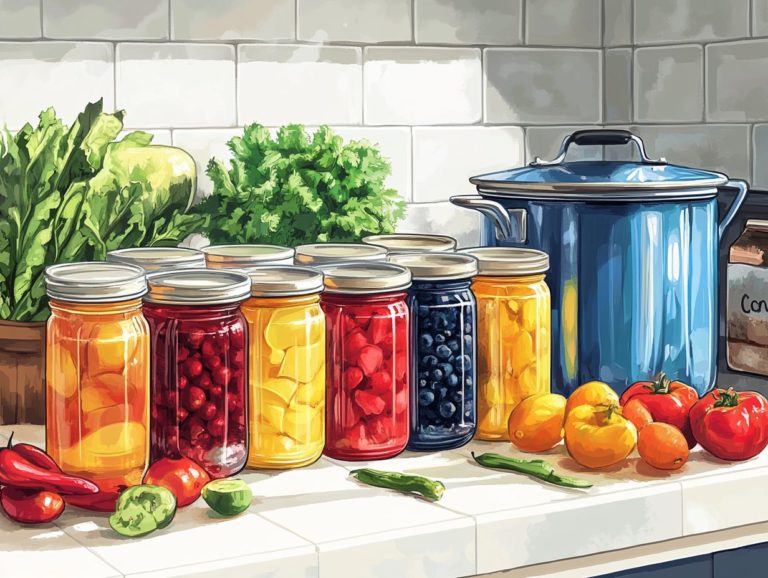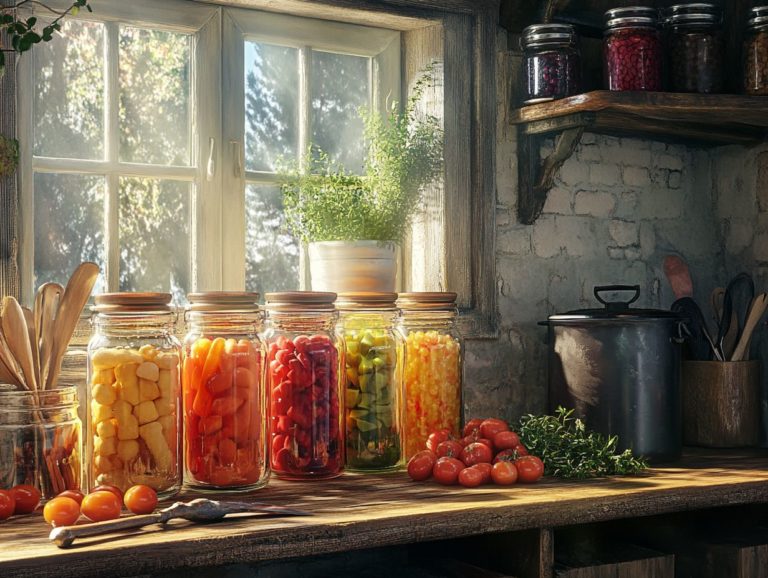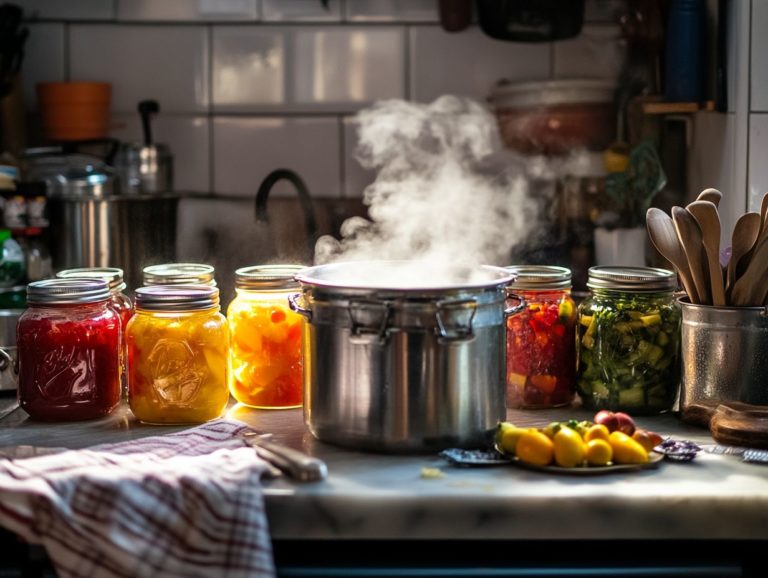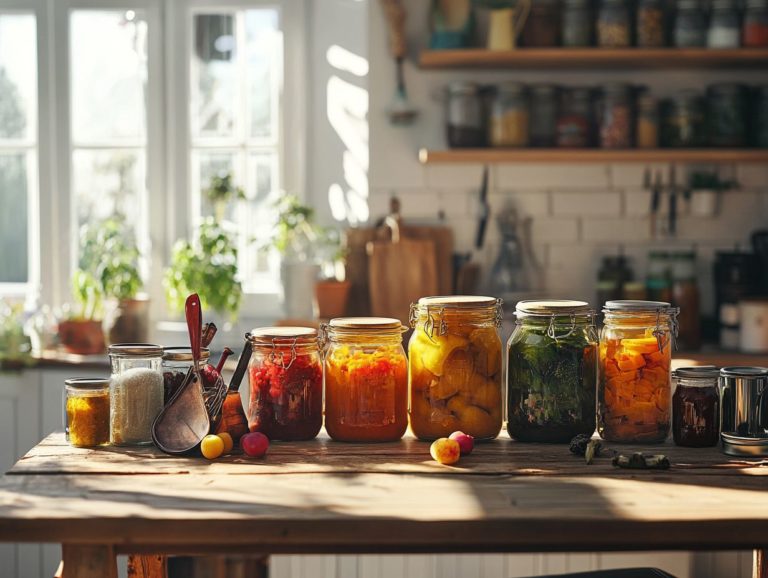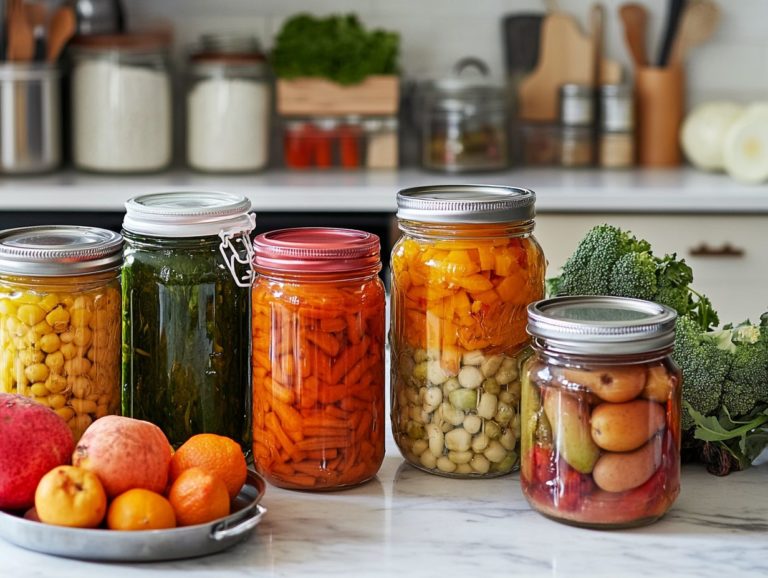The Role of Water Quality in Canning
Canning is a time-honored method of preserving food. But have you ever considered just how crucial water quality is to this process?
From the source of your water to potential contaminants, every factor can significantly influence both the safety and taste of your canned goods. This article delves into the importance of water quality in canning, providing insights into testing methods, treatment options, and best practices to ensure your preserves maintain their flavor and shelf life.
Whether you re a seasoned canner or just embarking on this culinary journey, grasping these aspects will empower you to achieve the best results.
Contents
- Key Takeaways:
- Factors Affecting Water Quality for Canning
- Testing Water Quality for Canning
- Ensuring Safe Water for Canning
- Impact of Water Quality on Canning Process and Products
- Frequently Asked Questions
- What is the role of water quality in canning?
- How does water quality impact the safety of canned foods?
- What are some common water quality issues that can affect canned foods?
- How can I ensure good water quality for canning?
- Can Poor Water Quality Affect Canned Foods?
- Best Practices for Maintaining Water Quality in Canning
Key Takeaways:
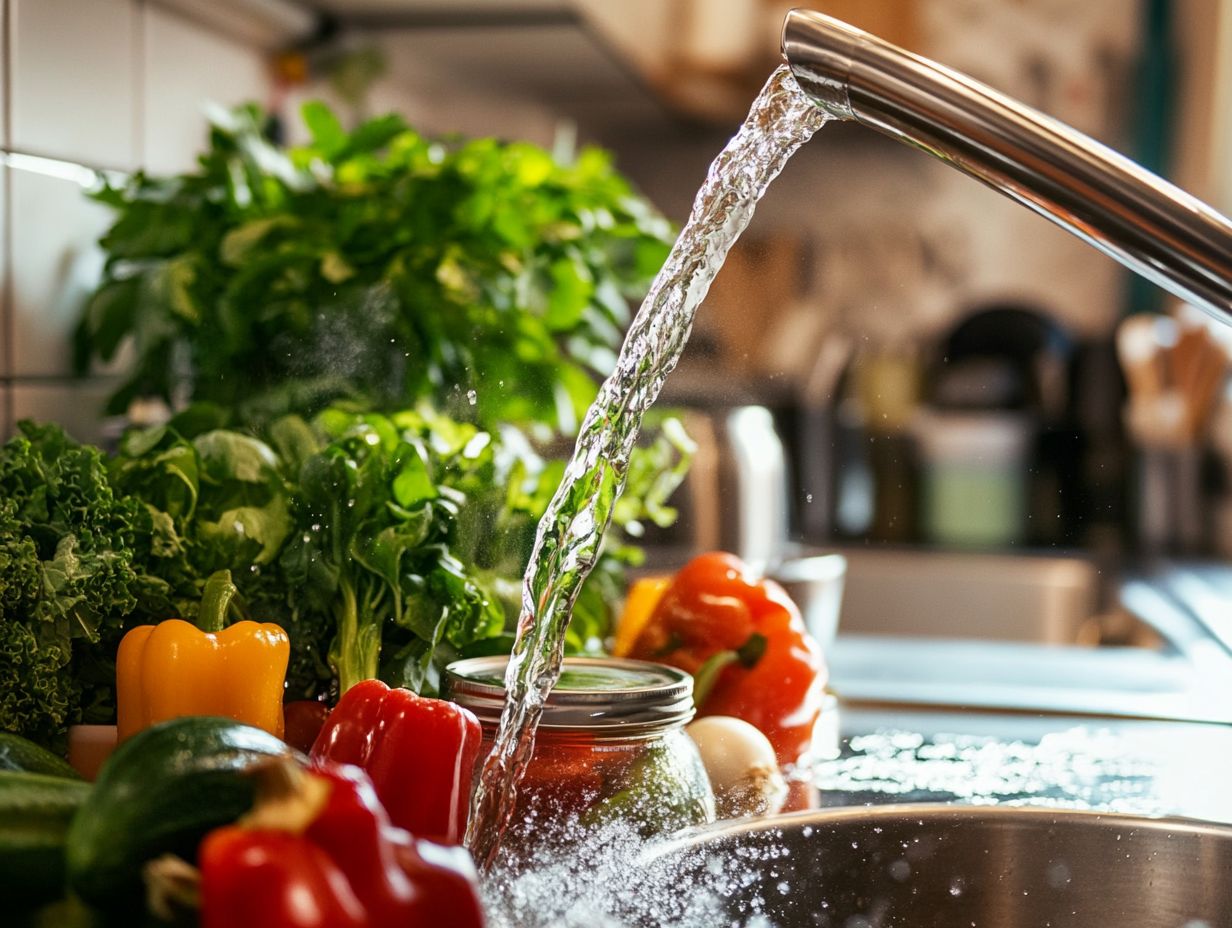
- Water quality is vital for taste, safety, and shelf life in canning.
- The source of water and potential contaminants should be regularly tested.
- Proper water treatment and maintenance practices are essential for quality.
What is Canning and Why is Water Quality Important?
Canning is a time-honored method of food preservation that involves sealing both high-acid and low-acid foods in jars to prevent spoilage and ensure safety. This process fosters self-sufficiency and keeps cherished traditions alive, allowing you to savor homemade goodness all year long.
The quality of water you use in canning is crucial. It directly influences the acidity levels of your food and the risk of spoilage. If you don t adhere to the proper USDA guidelines, it can also lead to the growth of botulinum toxin, a dangerous substance that can grow in improperly canned foods and pose serious health risks.
Good quality water helps maintain stable pH levels, vital for high-acid foods like tomatoes and pickles. These items are less likely to harbor harmful bacteria. On the flip side, low-acid foods such as green beans and corn demand vigilant monitoring to prevent contamination.
When you use contaminated water, you risk introducing harmful particles that could disrupt the canning process. These pathogens, such as Clostridium botulinum, can thrive in unsafe conditions.
Follow food safety practices to keep your preserves flavorful and safe for everyone to enjoy!
Factors Affecting Water Quality for Canning
Understanding the factors that impact water quality for canning is crucial for safeguarding food safety and successfully preserving your cherished recipes, from pickling to fruit syrups.
- Water source
- Contaminants
- Jar cleanliness
These elements can profoundly affect not only the canning process but also the integrity of the final product.
Source of Water
The source of water you choose for canning plays a crucial role in the safety and quality of your preserved foods. Consider options like filtered water or reputable filters such as Mavea and Brita.
Various water sources, including tap, well, and spring water, can contain contaminants that jeopardize the integrity of your canned goods. Impurities like chlorine, heavy metals, and microorganisms not only alter flavors but pose potential health risks.
By opting for filtered water, you enhance the taste of your preserves while significantly reducing the chances of spoilage. Utilizing systems designed to effectively diminish these contaminants ensures a safer canning process.
Whether you choose pitcher filters or faucet-mounted systems, prioritizing water quality is vital for achieving food safety and maintaining the integrity of your home-preserved foods.
Contaminants and Their Effects

Contaminants in water can pose serious risks to your food safety during the canning process. This can lead to food spoilage and the potential growth of harmful bacteria like Clostridium botulinum.
Contaminants may include heavy metals like lead and mercury. They can also come from agricultural runoff, which often contains pesticides and fertilizers, as well as biological agents such as viruses and protozoa.
Each of these elements can directly compromise the integrity of your canned foods. They affect their flavor, texture, and pose significant health hazards.
Food safety should always be your top priority. Without proper attention to water quality, the risk of spoilage increases. This can lead to not just financial losses but also serious health implications for consumers.
Ensuring clean water sources is critical for successful preservation. It helps mitigate risks and fosters a safe canning environment.
Testing Water Quality for Canning
Testing water quality for canning is an essential step to guarantee that the water you use doesn t jeopardize the safety and integrity of your preserved foods.
By utilizing a range of methods, you can pinpoint potential contaminants that could threaten food safety. This leads to a successful canning experience.
Methods for Testing Water Quality
Several effective methods for testing water quality can help ensure food safety during the canning process. These include home test kits, laboratory analysis, and visual inspections.
Home test kits are incredibly convenient, allowing you to get immediate results. This is why they re a popular choice for those concerned about their water source. These kits can identify basic contaminants like nitrates and pH levels. However, keep in mind that they have limitations and may not detect more complex pollutants.
Laboratory analysis, though more time-consuming and potentially costly, provides a thorough evaluation of water quality. This method can pinpoint harmful substances such as heavy metals, bacteria, and pesticides, giving you peace of mind.
Visual inspections can also come in handy, offering a quick look at clarity and color. However, they aren’t definitive. It’s wise to supplement them with more thorough methods to ensure comprehensive food safety during your canning process.
Ensuring Safe Water for Canning
Explore a variety of water treatment options now to ensure safe canning! You must embrace best practices that uphold superior water quality throughout the preservation process.
Preserving food is vital, and each jar you seal reflects your dedication to safety and quality.
Water Treatment Options
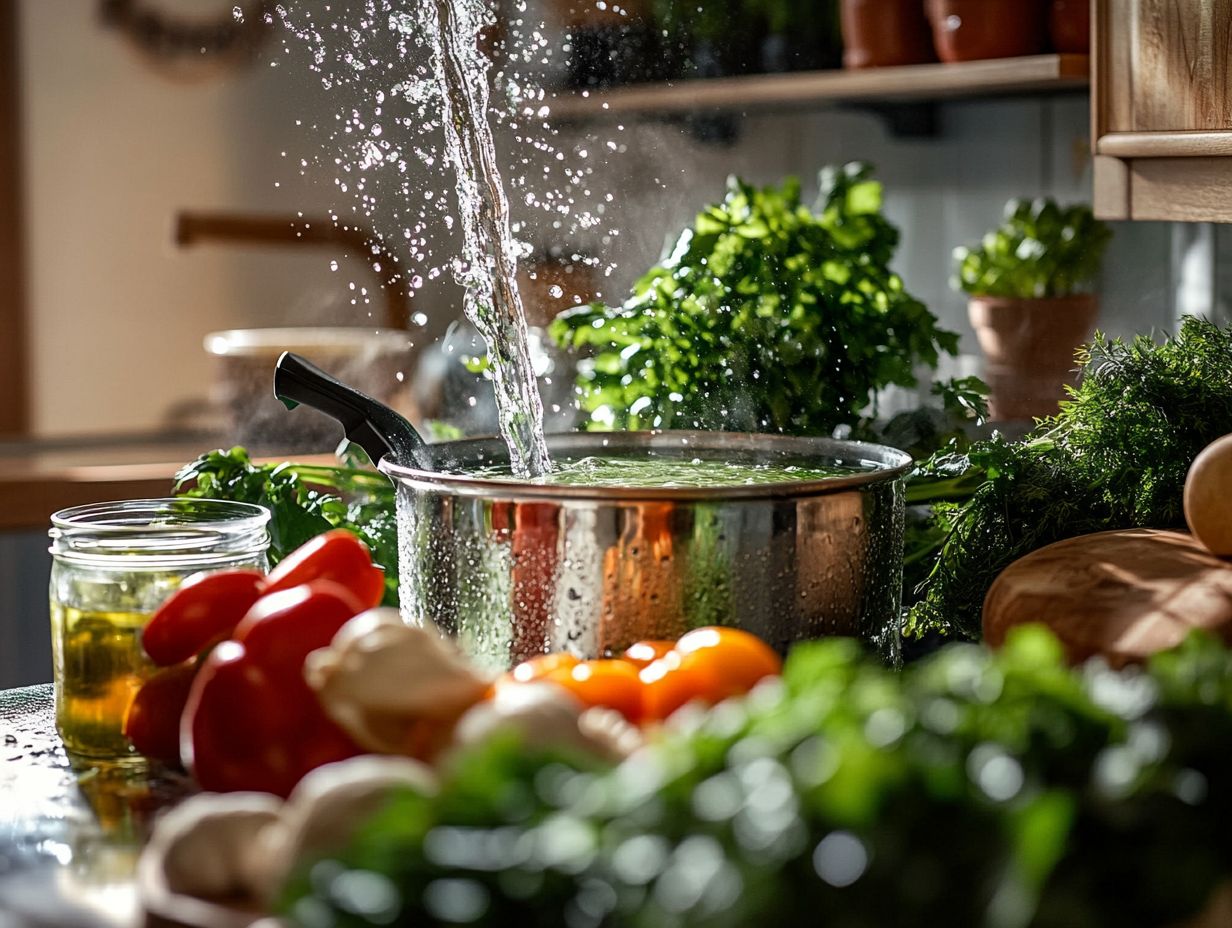
Several effective water treatment options are available for your canning endeavors. These can significantly enhance both safety and quality.
Consider filtration systems like Mavea and Brita, alongside traditional boiling water methods. Filtration systems harness the power of activated carbon or reverse osmosis, a method that removes impurities by pushing water through a special membrane.
On the flip side, boiling water is a tried-and-true method that efficiently eliminates biological pathogens. This ensures that harmful microorganisms do not jeopardize the safety of your canned products. While each technique boasts its own strengths, grasping their effects on overall water quality is crucial for anyone serious about preserving food in a safe and effective manner.
Best Practices for Maintaining Water Quality
Maintaining water quality is crucial for safe canning. Implementing best practices reduces food spoilage risks and ensures safety.
Incorporate specific strategies into your canning routine. Regularly inspect your jars for cracks or chips that could compromise seals.
Always use clean, intact jars. Avoid touching the interior with your hands to prevent contaminants.
Choose water from clean, reliable sources. Filtered or spring water enhances the safety of your canning process.
Follow these tips to enjoy your best homemade preserves yet!
Impact of Water Quality on Canning Process and Products
The quality of water you use in the canning process significantly influences both the canning itself and the final products. This choice impacts essential factors like shelf life, taste, and overall food preservation, underscoring the importance of selecting the best water for your endeavors.
Effects on Shelf Life and Taste
Water quality plays an important part in determining both the shelf life and taste of canned foods. Using poor-quality water can lead to undesirable flavors and diminish shelf stability.
When manufacturers opt for water that is contaminated or has an imbalanced mineral composition, it can significantly alter the flavor profile of the final product and compromise its preservation effectiveness.
For example, chlorine or heavy metals present in the water can interact with the ingredients during processing, resulting in off-flavors that detract from the intended taste experience. Subpar water quality can shorten the shelf life of canned products by introducing bacteria or influencing acidity levels, which are crucial for preventing spoilage.
Even slight variations in water pH can lead to notable changes in texture and taste, highlighting the importance of selecting high-quality water in the canning process for achieving optimal results.
Frequently Asked Questions
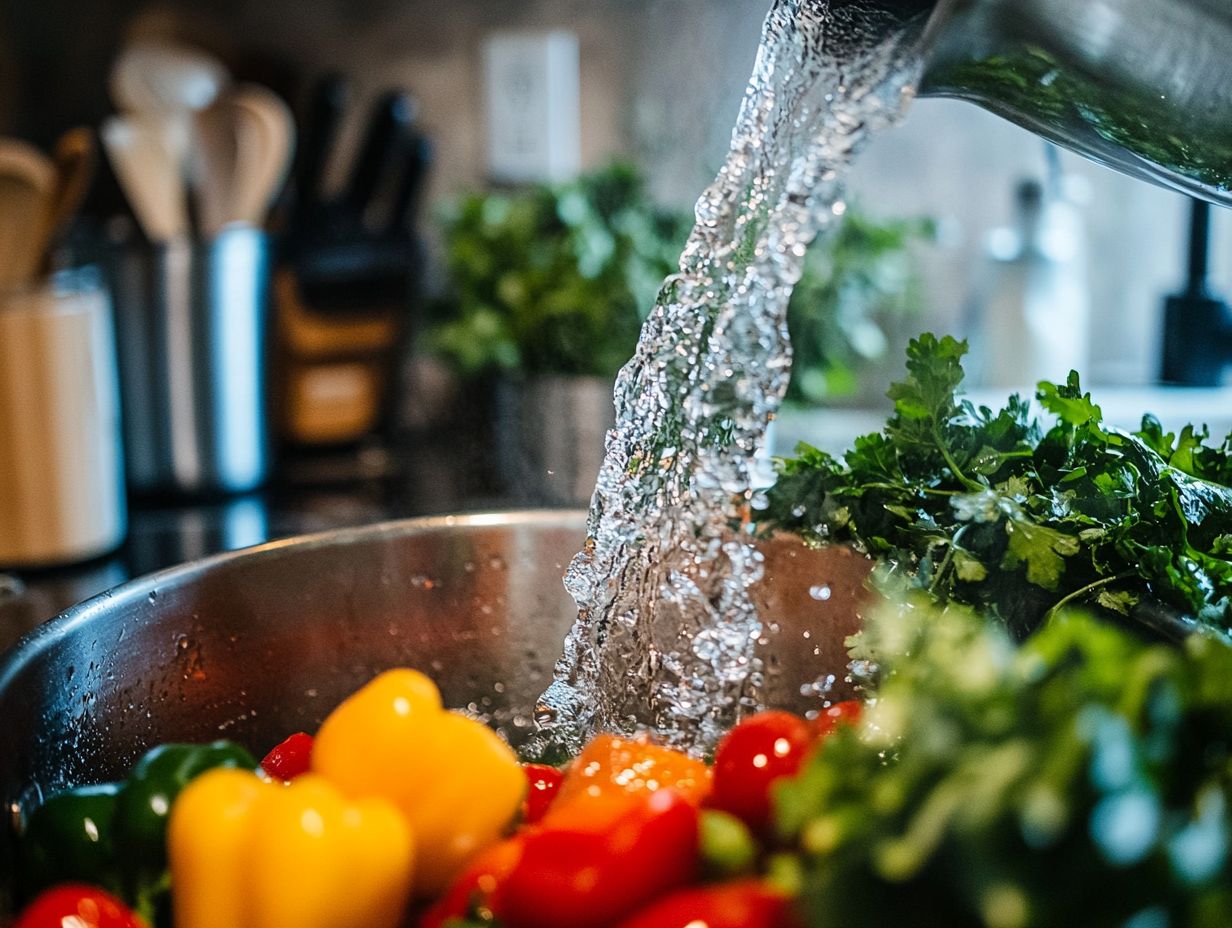
What is the role of water quality in canning?
The quality of water used in the canning process plays a crucial role in the safety and quality of the final product. It affects the texture, flavor, and appearance of canned foods, as well as the shelf life and potential for bacterial growth. When canning high-acid foods, careful attention to water quality and the level of acid in food, which can affect preservation, is particularly important.
How does water quality impact the safety of canned foods?
Poor water quality can introduce harmful bacteria and contaminants into canned foods, leading to foodborne illness. Don’t compromise your health use clean, potable water in the canning process to ensure the safety of the final product.
What are some common water quality issues that can affect canned foods?
Common water quality issues that can impact the safety and quality of canned foods include the presence of bacteria, nitrates, lead, and other contaminants. These can come from various sources such as groundwater, surface water, or plumbing systems.
How can I ensure good water quality for canning?
To ensure good water quality for canning, it is recommended to use potable water from a municipal source or a well that has been tested and deemed safe for consumption. Regularly test the water source for any potential contaminants.
Can Poor Water Quality Affect Canned Foods?
Poor water quality can lead to color changes, cloudiness, and off-flavors in canned foods. This may also make the texture mushy or tough, which can be unappetizing.
Best Practices for Maintaining Water Quality in Canning
Regularly clean and sanitize all equipment used in canning. Using a water treatment system, like filtration or purification, helps eliminate potential contaminants.

